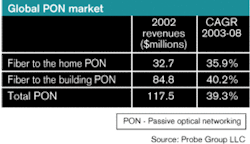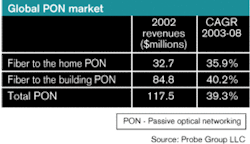PON market shows signs of recovery
The FCC's recent favorable decision on the unbundled network-element platform (UNE-P) states that regional Bell operating companies do not have to share their broadband access equipment with competing service providers, clearing one of the perceived obstacles to PON deployments in the United States. Most of the growth in Asia has taken place in the fiber to the building (FTTB) PON market, says Probe research analyst Maria Zeppetella. "Japan's NTT has not only developed a number of PON technologies with systems vendors," reports Zeppetella, "but last fall it began commercially deploying FTTB multidwelling units/apartment buildings as well as fiber to the home in large scale. Service providers in South Korea, Singapore, Taiwan, and China have been trailing PON equipment and look ripe for commercial PON FTTB deployments in the coming year."
According to Probe research, there is no longer a debate about ATM PON versus Ethernet PON; service providers are now utilizing the technology that best suits their needs for a specific network or market. In addition, the International Telecommunication Union recently approved the protocol-agnostic gigabit PON standards using generic framing protocol.
For more information about the report, "Global Passive Optical Networking Market: 2002-2008," visit the company's Website, www.probegrp.com.

